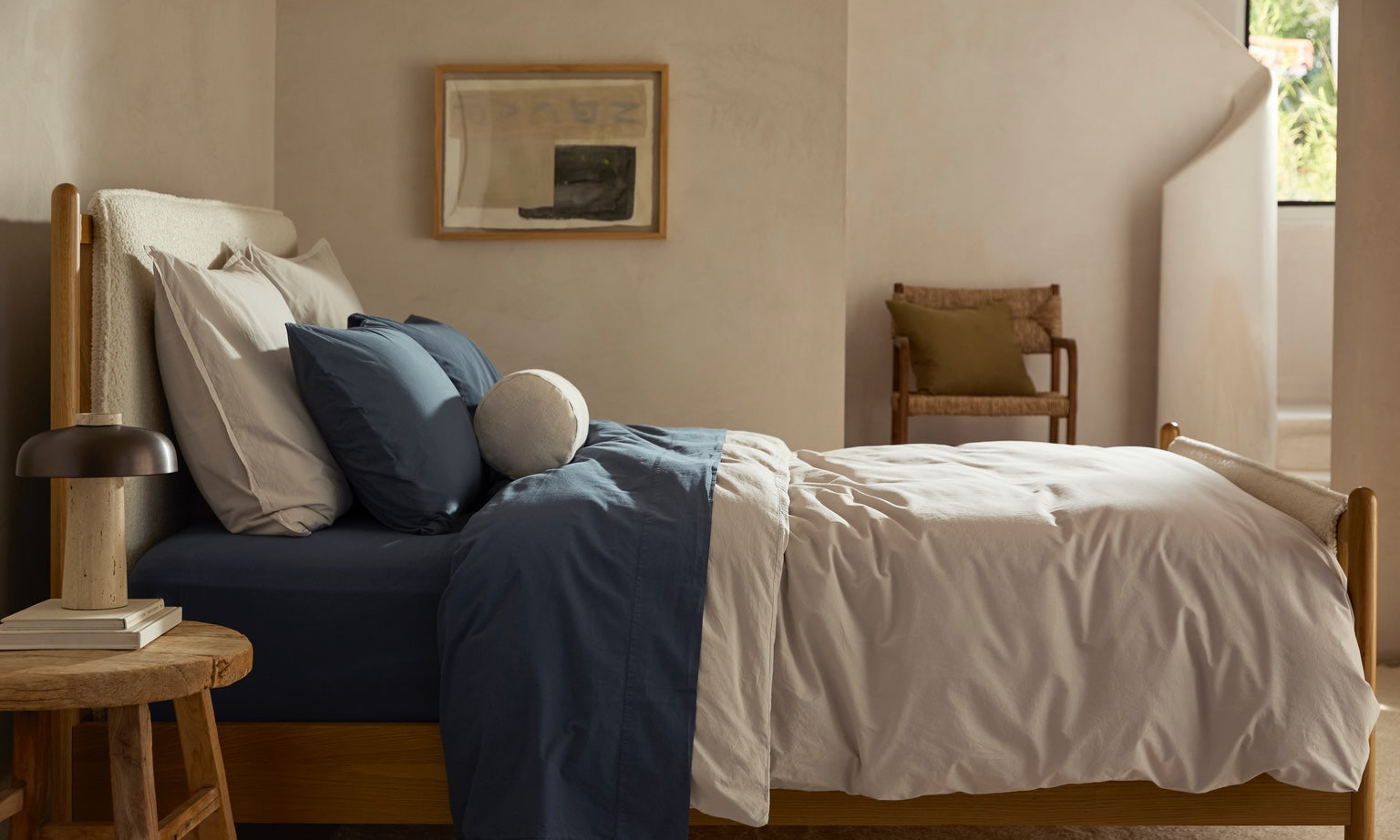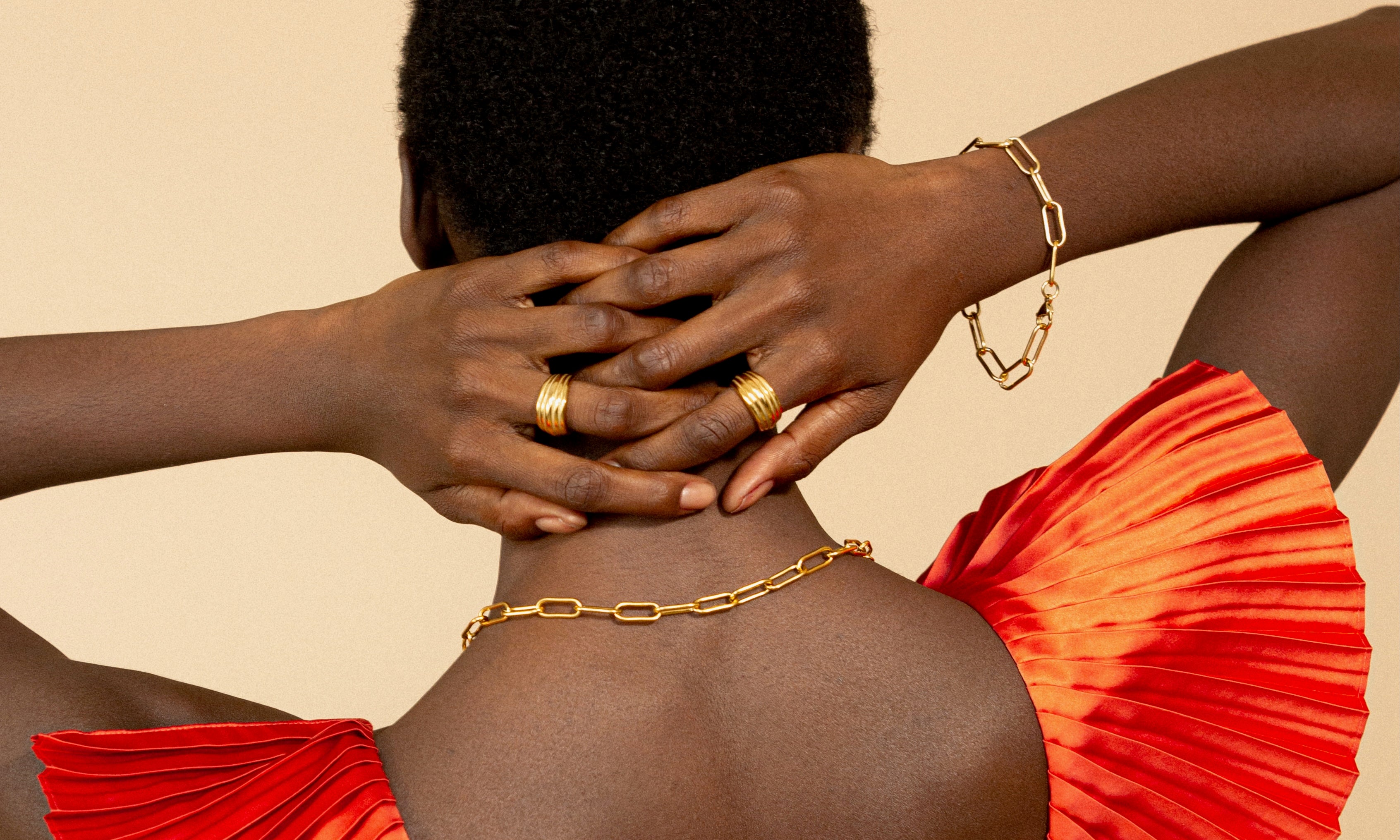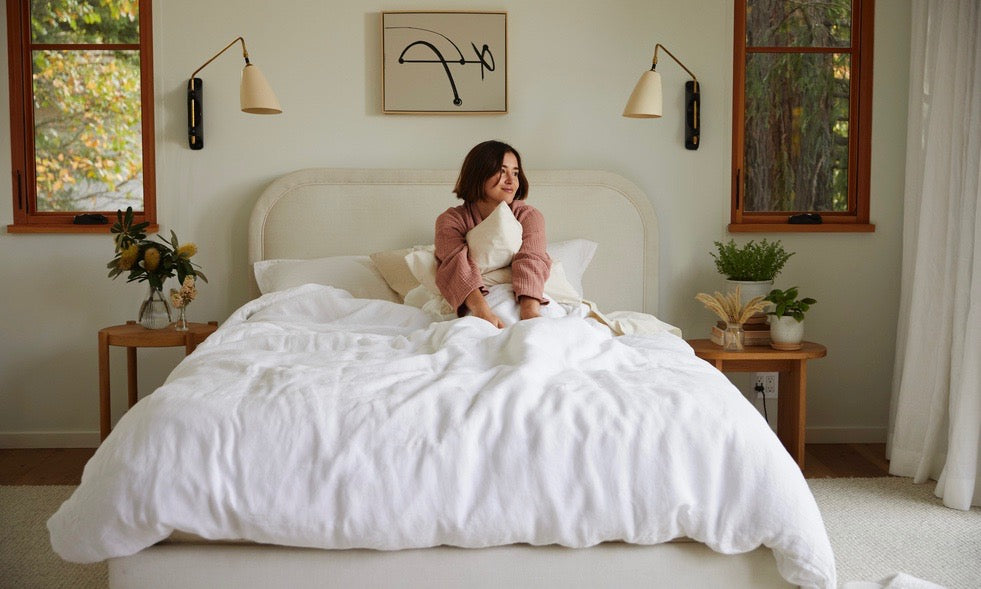
What Is a Duvet? What Makes It Different?
So, what is a duvet and what are comforters, and are they any different from duvet inserts? You're not the first person to wonder.
A good night's sleep starts with the right bedding. Beyond a supportive mattress and comfy pillows that align with your sleeping style, the right layers are crucial. Yet not all bedding pieces are self-explanatory — especially the duvet.
So, what is a duvet and what are comforters, and are they any different from duvet inserts? You're not the first person to wonder. You’ll find answers below, along with information about the best duvet materials, the benefits of sleeping with one, and tips for buying a high-quality duvet.
What Is a Duvet?
A duvet is a type of bedspread. It consists of a fabric shell stuffed with fluffy, insulating fill material, such as natural goose down or down-alternative fibers. To prevent the filling from bunching up, the shell typically features box quilting. A duvet is meant to go inside a duvet cover.
What Is a Duvet Insert?A duvet insert is a duvet without its cover. It consists of a quilted fabric shell and a lofty, insulating fill material, like goose or duck-down, or down-alternative fibers. Since duvet inserts are designed to go inside machine-washable duvet covers, they're usually plain white and not decorative.
How Does a Duvet Work?A duvet insert is essentially a quilted bed cover filled with natural down or down-alternative fibers. The idea is that the fluffy, insulating design offers lightweight warmth without weighing you down or trapping heat.
Since the duvet itself may or may not be machine-washable — and might not be washed as often as other bedding — it's supposed to go inside a removable, washable duvet cover.
What Is a Duvet Cover?A duvet cover is a machine-washable enclosure that goes over a duvet insert. It's designed to protect the duvet from dirt, dust, spills, sweat and other residues. Whether made of cotton, linen, or a textile blend, the skin-friendly fabric is generally soft, breathable, and moisture-wicking.
For more on this topic, see our blog: What Is a Duvet Cover?
Duvet Insert vs. Duvet CoverA duvet insert and duvet cover are two separate bedding pieces — and they're usually purchased separately. An insert is most often plain white and may or may not be machine-washable.
The cover, on the other hand, is made of a soft, breathable fabric and typically has buttons or a zipper closure on the bottom (foot side). To prevent the duvet from sliding around inside the cover, some covers have corner ties that fasten to tabs on the corners of the insert.
Even if your duvet insert is washer-friendly, you don't necessarily need to wash it very often — once every three months should suffice. That said, you can take off the duvet cover and wash it as often as you wash your sheets (about once a week).
In most cases, you wouldn't want to use a duvet insert on its own. Even if you're a fan of all-white bedding, the plain design isn't as presentable as having a white duvet cover and matching pillow shams. Plus, using it without a cover would likely lead to stains.
See our Guide to Duvets and Duvet Covers for a deeper dive into this topic.
Duvet vs. ComforterThe words duvet and comforter are often used interchangeably, especially in the U.S. But while both are types of bed covers, they're technically two different things. A duvet insert is designed to go inside a washable duvet cover, whereas a comforter could theoretically be used without a cover.
Having said that, to be used without a cover, a comforter should be presentable as-is, meaning it'll feature a solid color or patterned design. It should also be easily machine-washable so you can launder it about as often as you wash your sheets.
Duvet Materials
What are duvets made of? Find a breakdown of the filler and shell materials below.
Duvet Filler MaterialWhat's inside a duvet is arguably the most important. The fill material is most often either down or down-alternative. Down comes from the undercoat of geese and ducks. It's super lightweight and fluffy yet naturally insulating and warm, not to mention breathable and moisture-wicking.
Down
Down is not technically the same as feathers. Feathers are the overcoat of the animal, whereas down is the bottom layer, closest to the skin. Duvet inserts can be filled with feathers (or a blend of down and feathers), but down is often preferred because the fibers are lighter, finer, and don't have pokey quills.
Down Alternative
Down-alternative is a good option for those who want vegan-friendly, animal-free bedding materials, as well as folks who might be allergic to natural down or feathers. The material is designed to mimic the inherent lofty, insulating qualities of real down.
Duvets and comforters can be filled with other natural materials like cotton or silk, but these are less common options.
See our Down vs. Down Alternative Comparison Guide for more insight.
Duvet Shell MaterialAs for the shell, you're usually looking at a smooth, soft fabric, such as cotton, sateen, or percale. You can also find duvets with polyester shells, but cotton or another natural textile is ideal.
Why? Cotton is inherently breathable, meaning air can pass through the fabric. This prevents it from trapping heat, which is crucial for hot sleepers. Cotton is also naturally moisture-wicking, meaning it helps draw sweat away from the body, so it's good for people who are prone to night sweats.
Benefits of Using a Duvet Insert and Cover
Why use a duvet insert with a cover rather than a comforter or another type of bedspread? Explore the multiple benefits below.
Easy to CleanHaving a removable cover makes your bedding easier to clean. Down-filled duvets can be cumbersome and require large washer drums, but with a cover, you can just take it off and toss it in the wash every time you launder your sheets.
More Fabric OptionsWhen you use a duvet cover with an insert, you have more choices in terms of fabrics. You can opt for various materials, like sateen, percale, brushed cotton, linen, organic cotton, or cloud cotton. And each material comes in a range of colors to suit your mood or seasonal decorative taste.
Can Change by SeasonSpeaking of seasonal decorating, interchangeable duvet covers give you the option to overhaul the look of your bed as often as you want. This is often a more affordable option than getting a whole new comforter.
Our guide on How to Organize Your Linen Closet has tips for storing out-of-season bed linens.
Customizable DesignsAnother benefit of duvets is that you can customize your sleeping experience. Whether you run cold and prefer cozier, insulating materials or are prone to night sweats and need something more breathable and moisture-wicking, you can choose a duvet cover that suits your needs.
As with the options you’ll find at Parachute, the insert itself might come in multiple weights, allowing you to select one that works best for your climate and sleeping style.
How to Find the Best Duvet
There are a few things to consider when shopping for a duvet insert. These include warmth, weight, material, size, and cost.
Warmth and WeightDuvets often come in multiple weights. Referred to as fill power, the weight is measured in grams per square meter (GSM) and usually ranges from roughly 500 to 800. Higher numbers indicate a loftier, more voluminous, warmer bed cover.
Of course, duvet weight is ultimately a matter of personal preference. If you run hot or get night sweats, a lightweight option might be best. But if you get cold while you doze or are looking for something for winter use, opt for a heavier, warmer duvet with more insulating fill fibers.
MaterialYou should also think about the materials you want to sleep with. Do you prefer natural down or animal-free, down-alternative fill? Are you partial to lighter-weight, breathable fabrics or are you interested in something that provides more insulation? Answering these questions can help you determine the best duvet materials for your unique needs and preferences.
See our Fabric and Bedding Materials Guide for more details about the different fill fibers and fabrics.
SizeLike bed sheets, duvet inserts are available in different sizes. This includes twin, twin XL, full, queen, king and California king. For a fuller, fluffier look, consider sizing up. For instance, if you sleep on a queen bed, stuff a king duvet into a queen-size duvet cover.
CostDuvets also vary in terms of price. Larger, high-quality options can cost a few hundred dollars, but they'll last longer than cheaper designs. Additionally, down-filled inserts are usually a little pricier than their down-alternative counterparts.
Frequently Asked Questions About Duvets
Find answers to frequently asked questions about duvets below.
Can I put a regular comforter inside a duvet cover?Yes, you can put a regular comforter inside a duvet cover. The words duvet and comforter are often used interchangeably, so it's sometimes just a matter of branding. With this in mind, any quilted bed cover filled with down or down-alternative fibers can be stuffed into a duvet cover.
Does the opening of the duvet go at the top or bottom of the bed?The opening of the duvet cover traditionally goes at the bottom (foot) of the bed. This keeps the buttons or zipper away from your face while you're sleeping. However, some people think it's more aesthetically pleasing to keep the opening at the top, and to each their own.
Do you use a blanket with a duvet?A duvet is a bed cover, and for many people, it provides enough warmth while sleeping. That said, you can certainly use a blanket with it if you want an extra layer of coziness. If not, just use a throw blanket when making your bed to add texture and create a layered look.
Can you use a duvet with a bedspread?A duvet is a type of bedspread, so it can typically be used on its own. However, if you want an additional layer of warmth, you can place a quilt, coverlet, or throw blanket on top.
See our Guide to Quilts, Blankets, and Coverlets for more insight into each type of bed cover.
Are duvets lightweight down comforters?In a sense, yes. A duvet can be a lightweight, down-filled version of a comforter. But you'll also find heavier, fluffier options with higher fill powers. While duvet and comforter are sometimes synonymous, duvets are quilted bed covers meant to go inside a duvet cover, whereas comforters can sometimes be used without a cover.
What is the best duvet cover?The best duvet cover is a matter of personal preference. But for most sleepers, it's a high-quality sateen or percale cotton shell filled with natural down or down-alternative fibers. A year-round design should provide fluffy warmth without trapping heat while helping to draw moisture away from the body.
High-Quality Duvets and Duvet Covers From Parachute
The duvet inserts you’ll discover at Parachute are among the best on the market. The high-quality designs feature silky-smooth sateen shells and ethically sourced goose down or down-alternative fills with high fill powers.
When you browse the bedding collection, you'll also find duvet covers and duvet sets with matching shams. Fabric options include brushed cotton, sateen, percale, linen, cloud cotton, and organic cotton, all Oeko-Tex certified for chemical safety.
CTA: Find your dream bedding
Read Next:
What Is Oeko-Tex? Learn About This Textile Certification Standard
How to Wash and Properly Care for Bedding
What Is a Top Sheet? Do You Actually Need One?
Down Comforter 101: What Is Fill Power?
How to Pick the Right Layer for You
External Sources:
1. Gao J, et al. (2007). Structures and Properties of the Goose Down as a Material for Thermal Insulation. Textile Research Journal. 77. 617-626. 10.1177/0040517507079408.
2. Kim, Hyun-Ah. Moisture Vapor Permeability and Thermal Wear Comfort of Ecofriendly Fiber-Embedded Woven Fabrics for High-Performance Clothing. Materials (Basel, Switzerland) vol. 14,20 6205. 19 Oct. 2021, doi:10.3390/ma14206205








